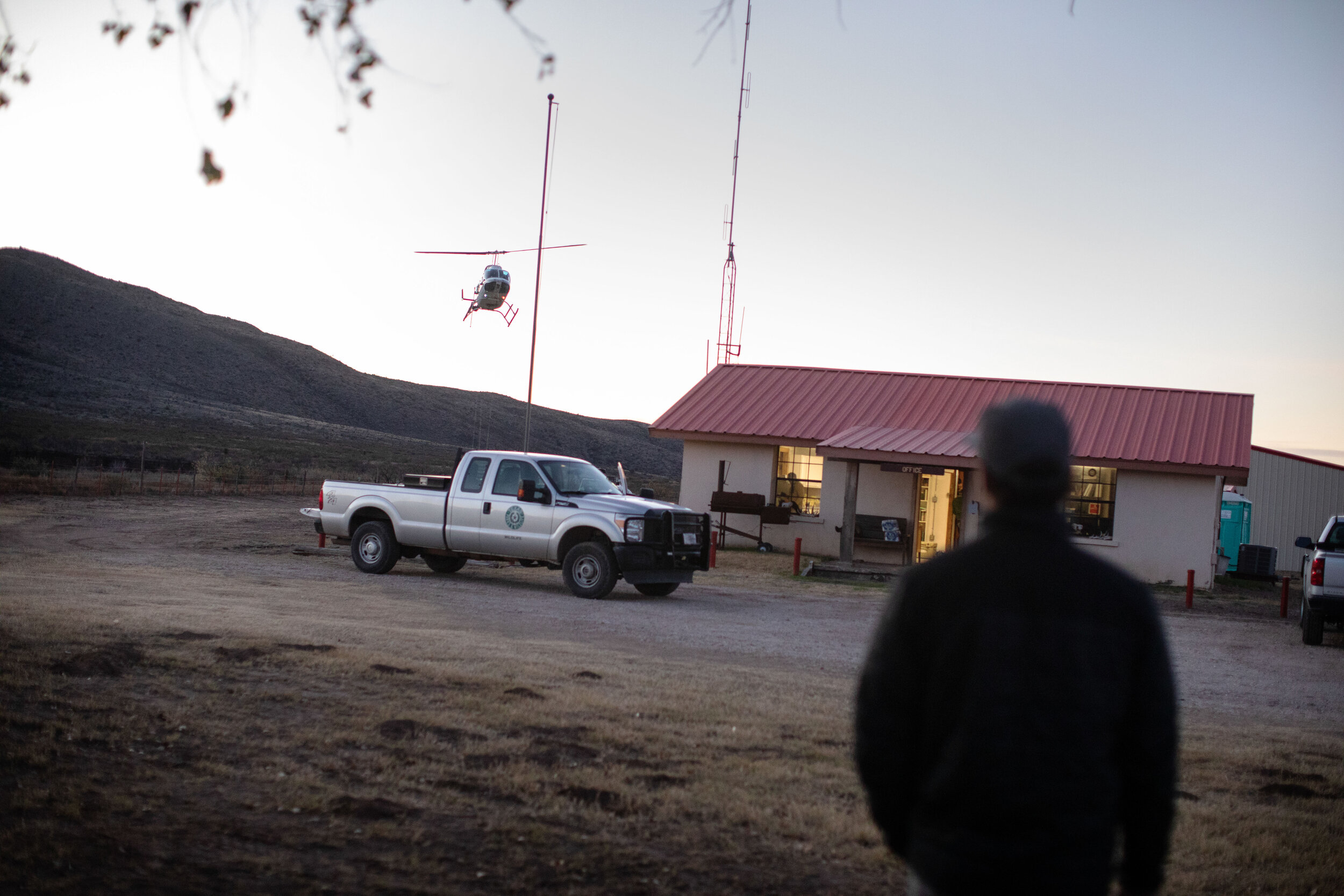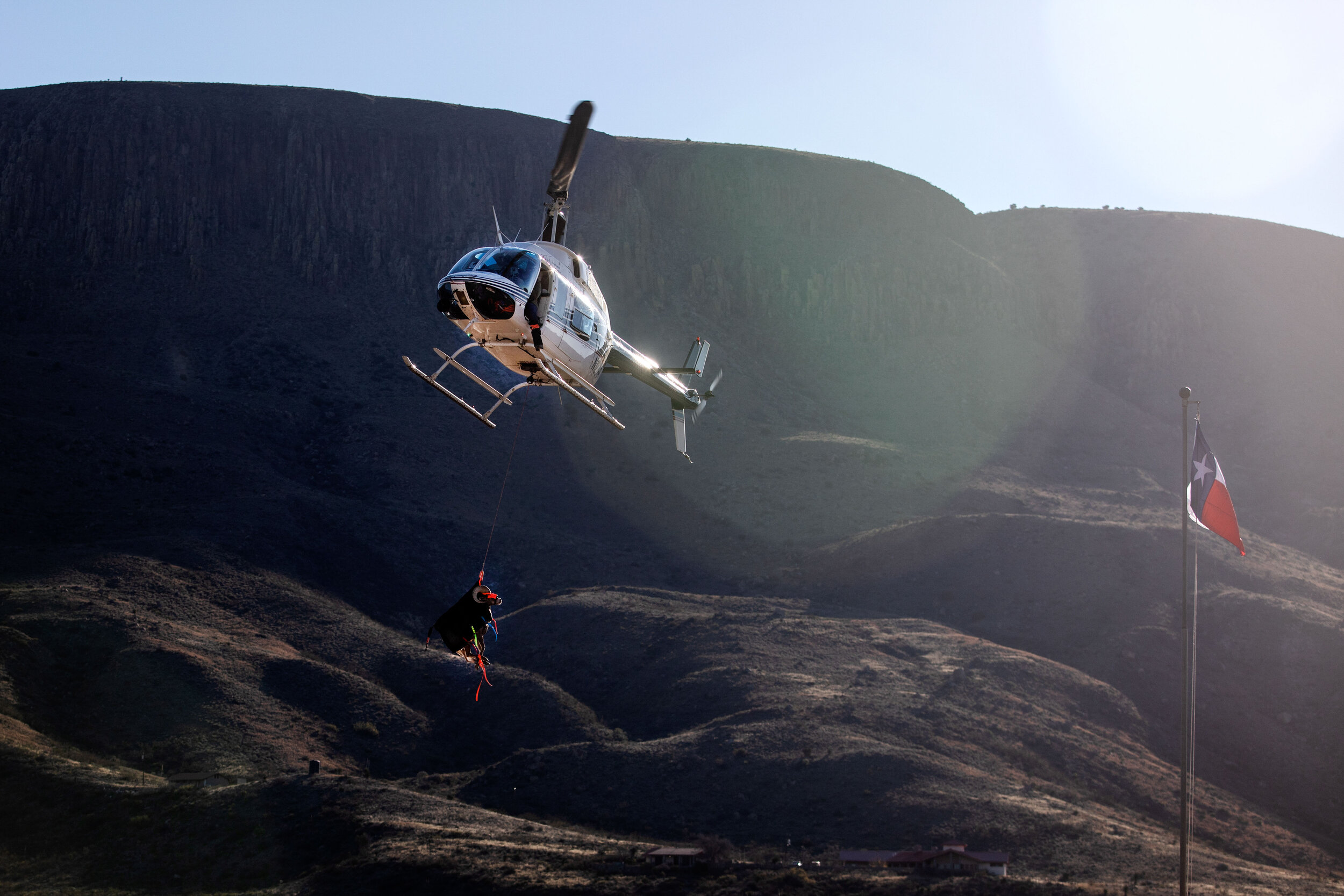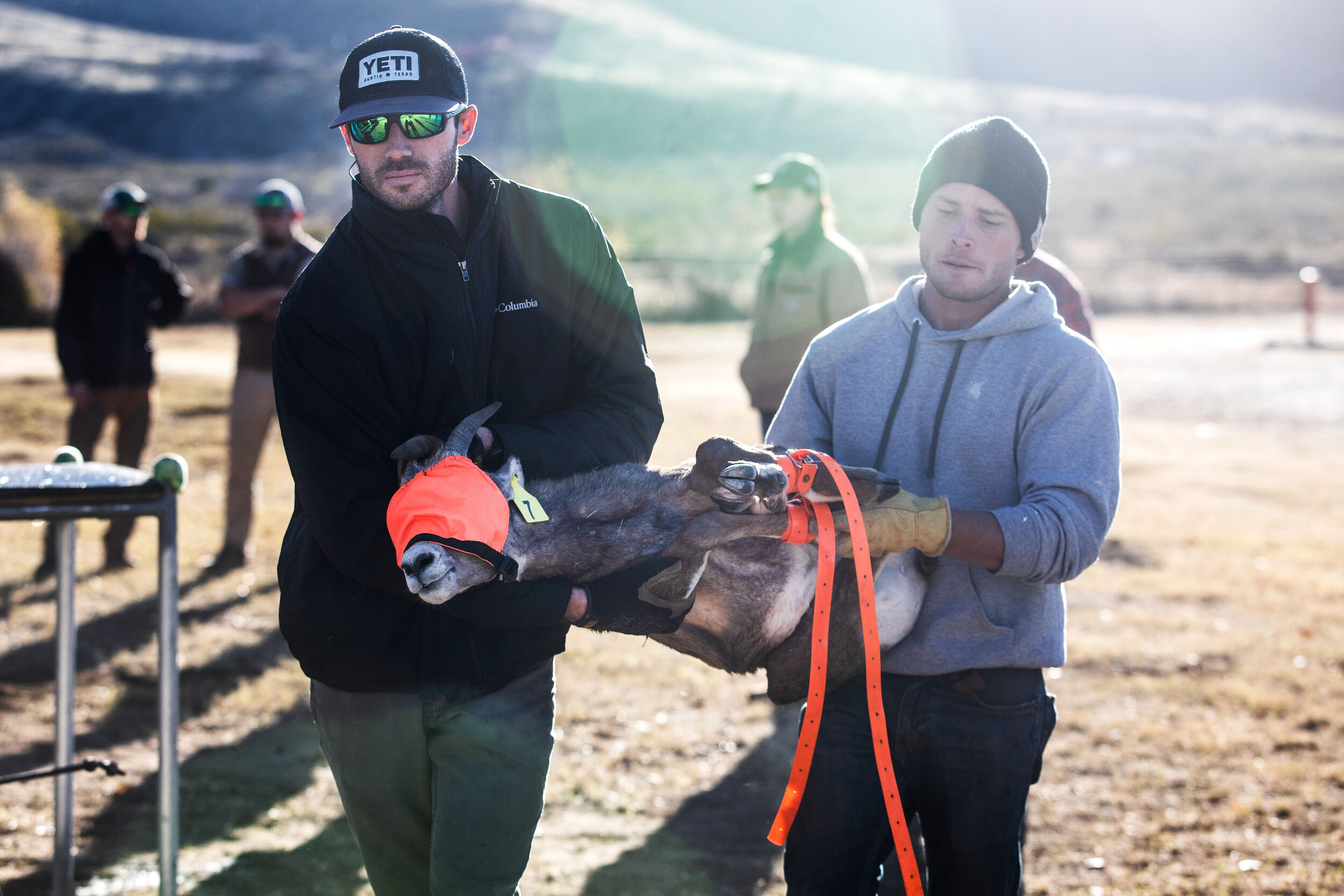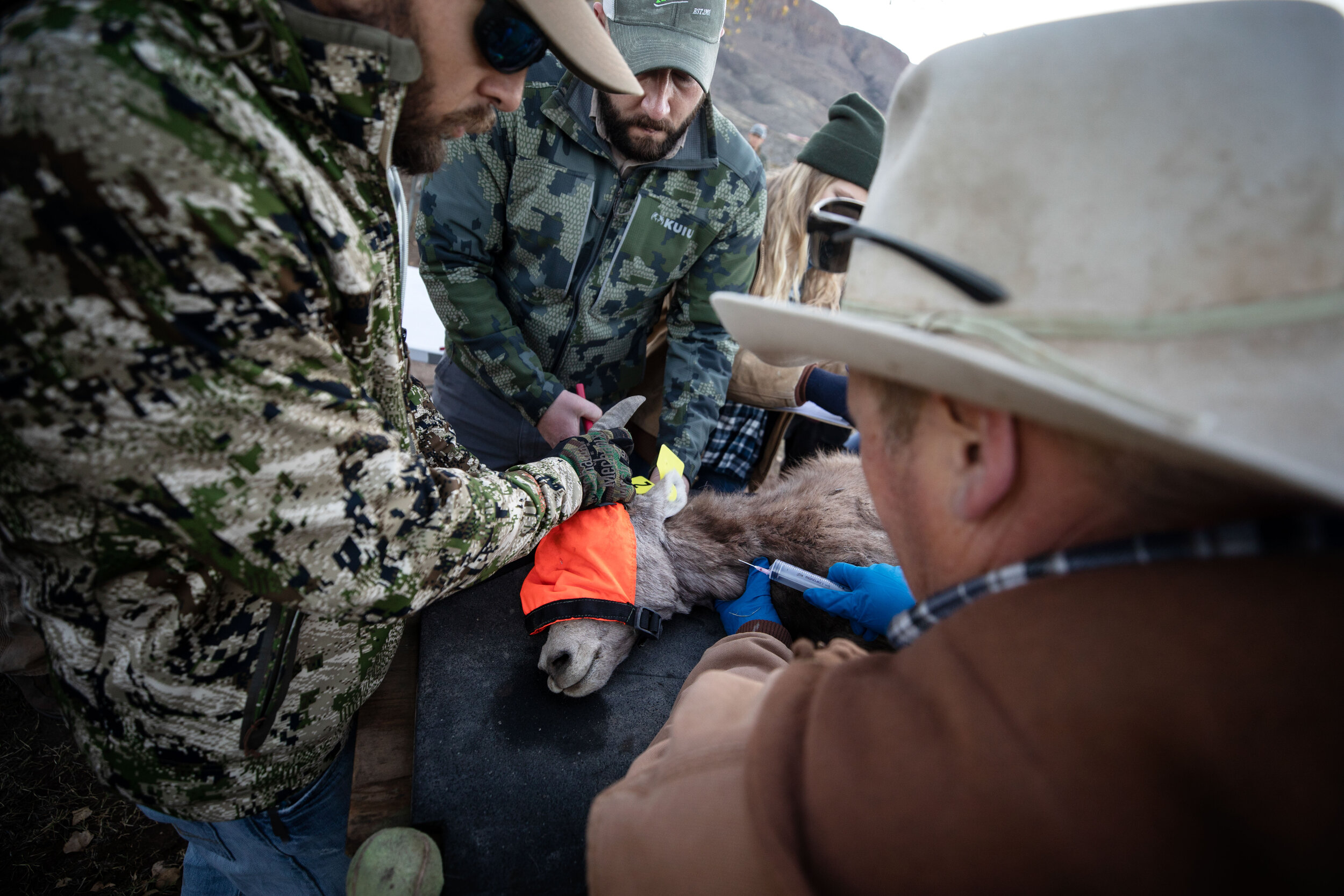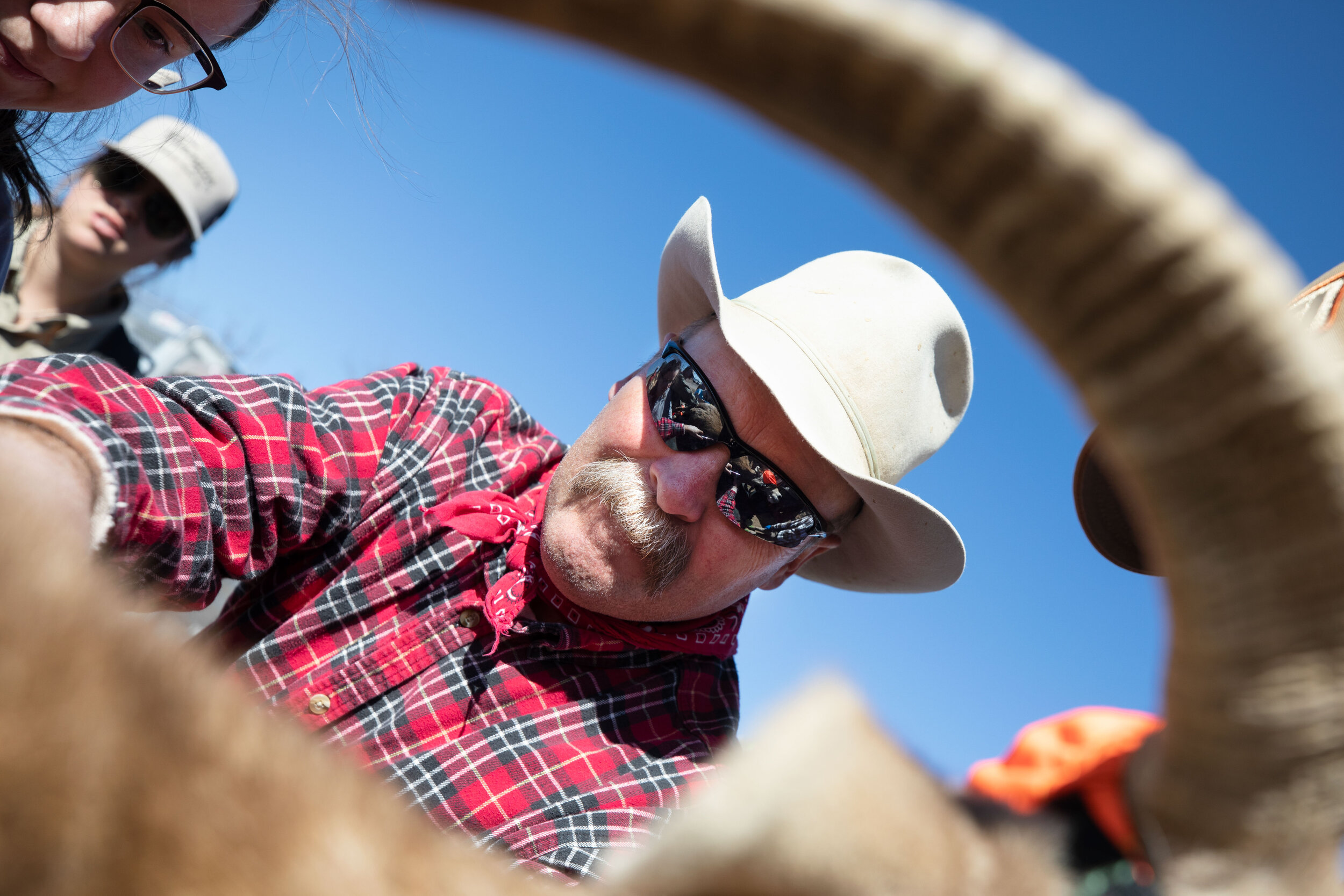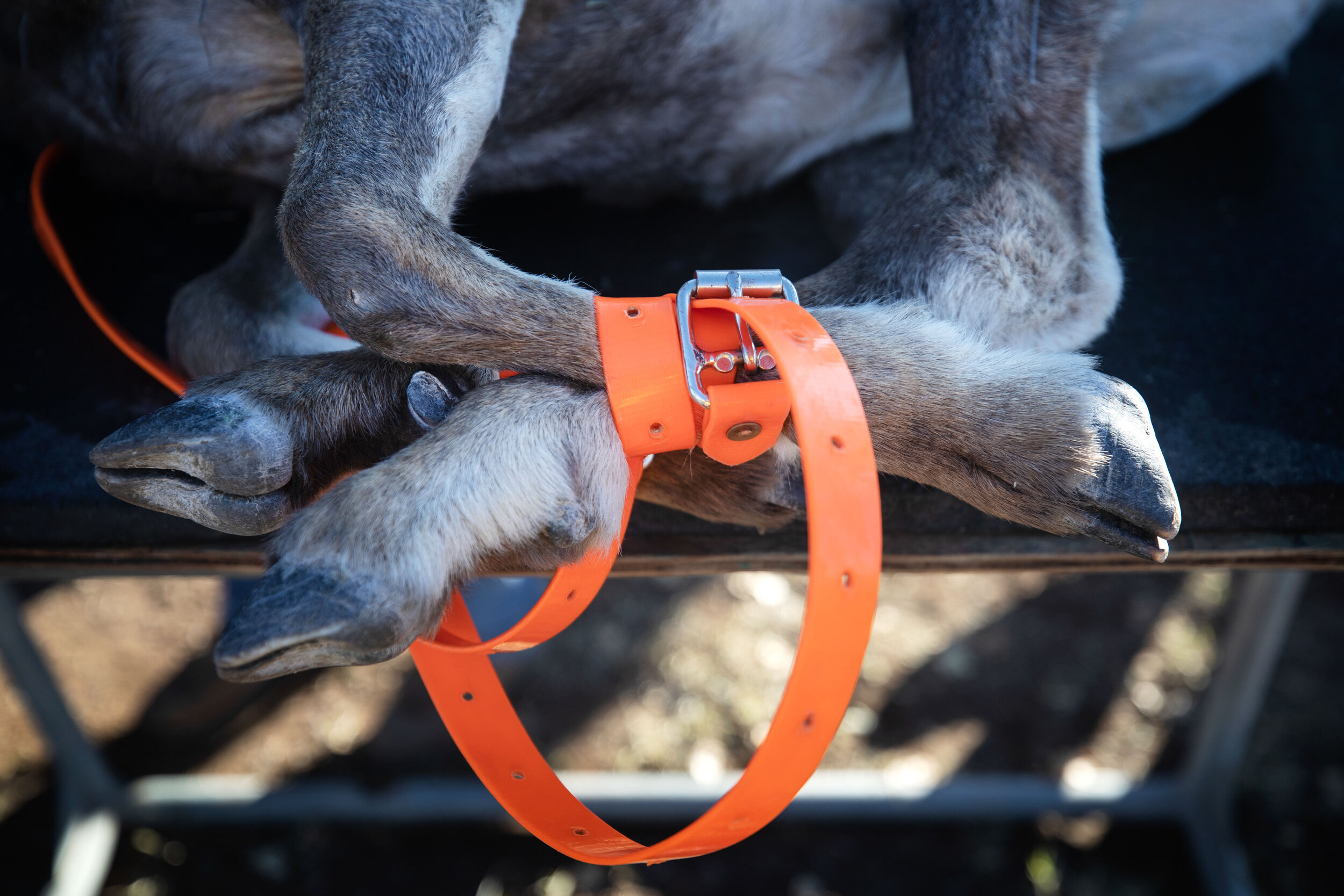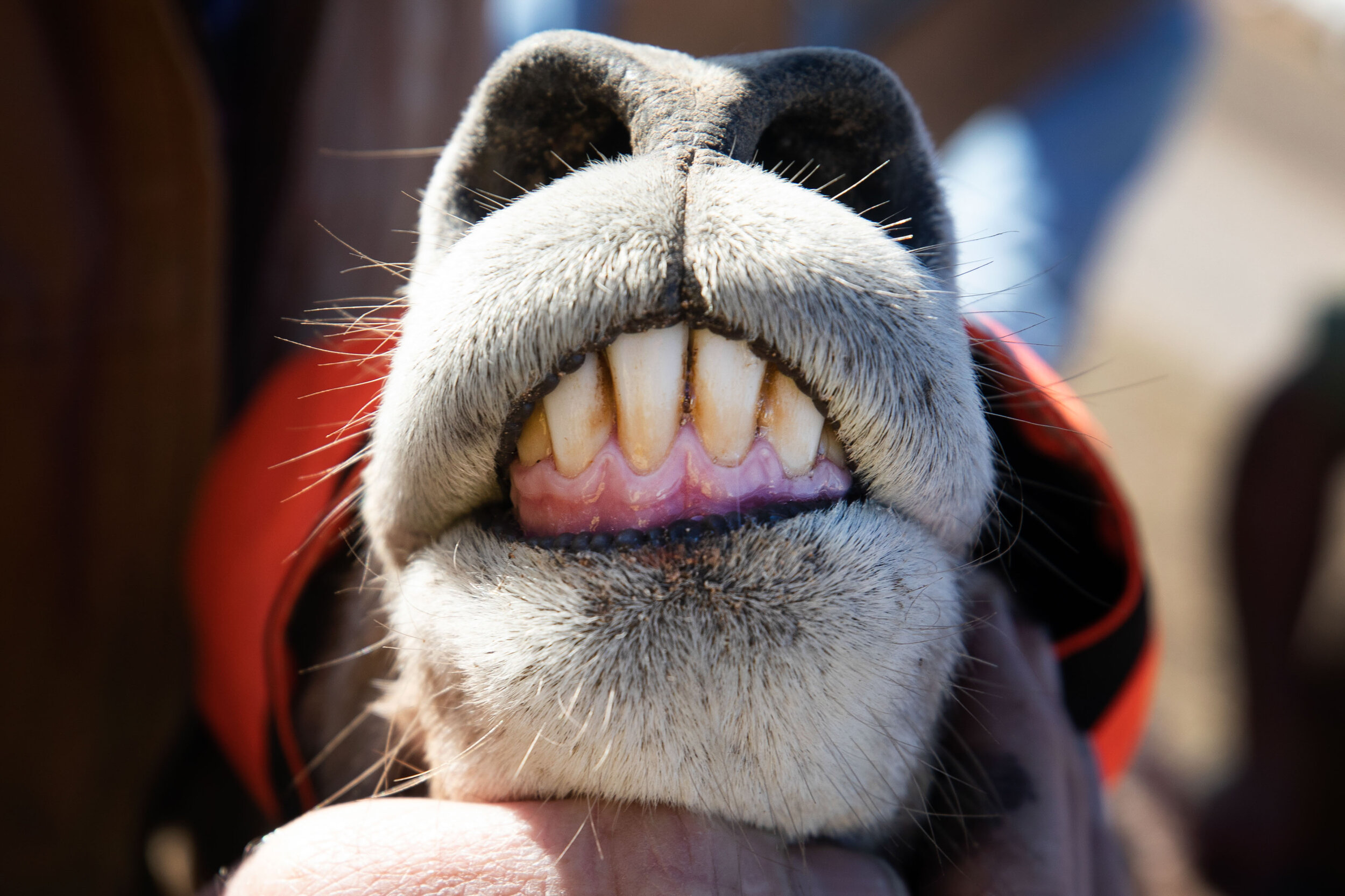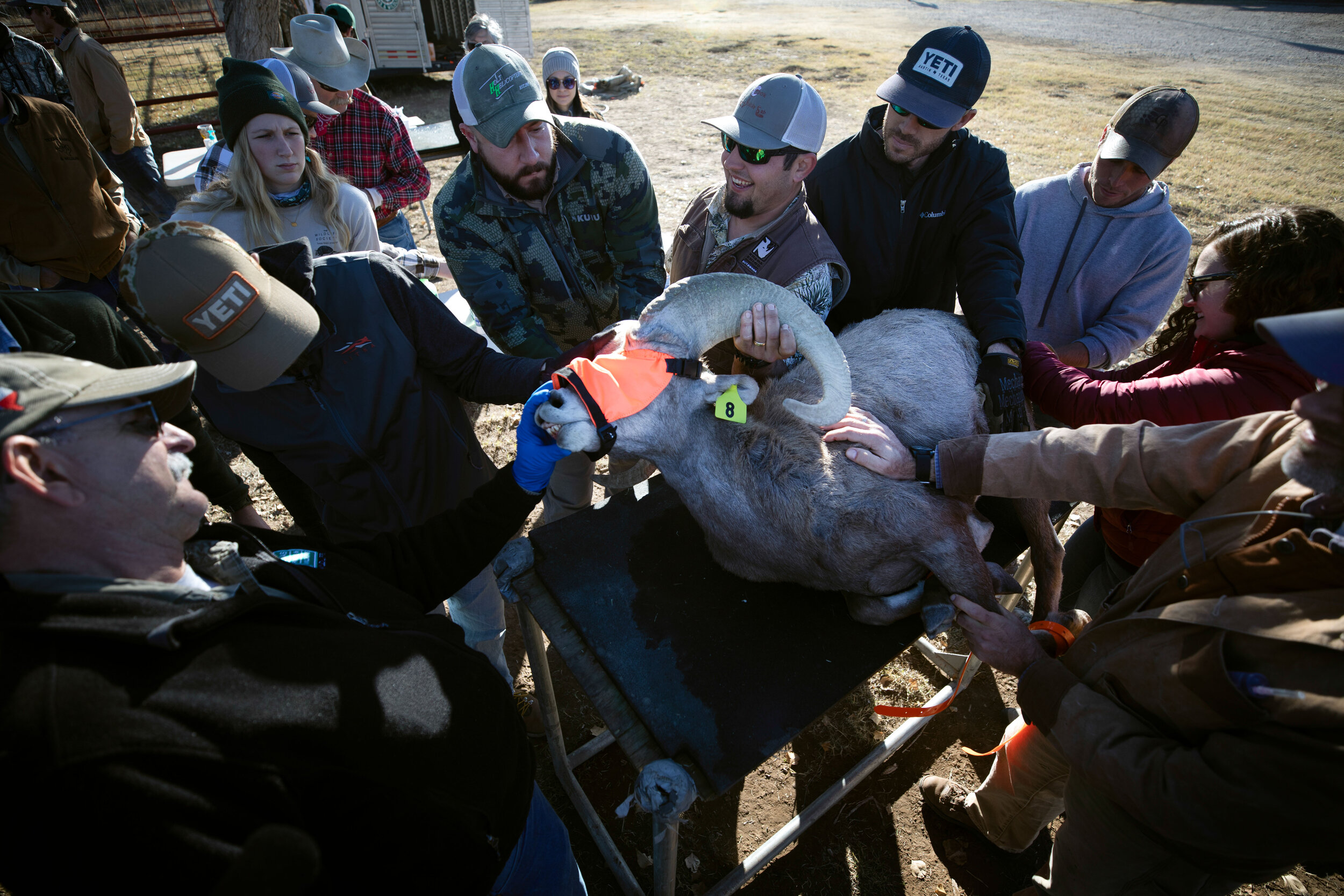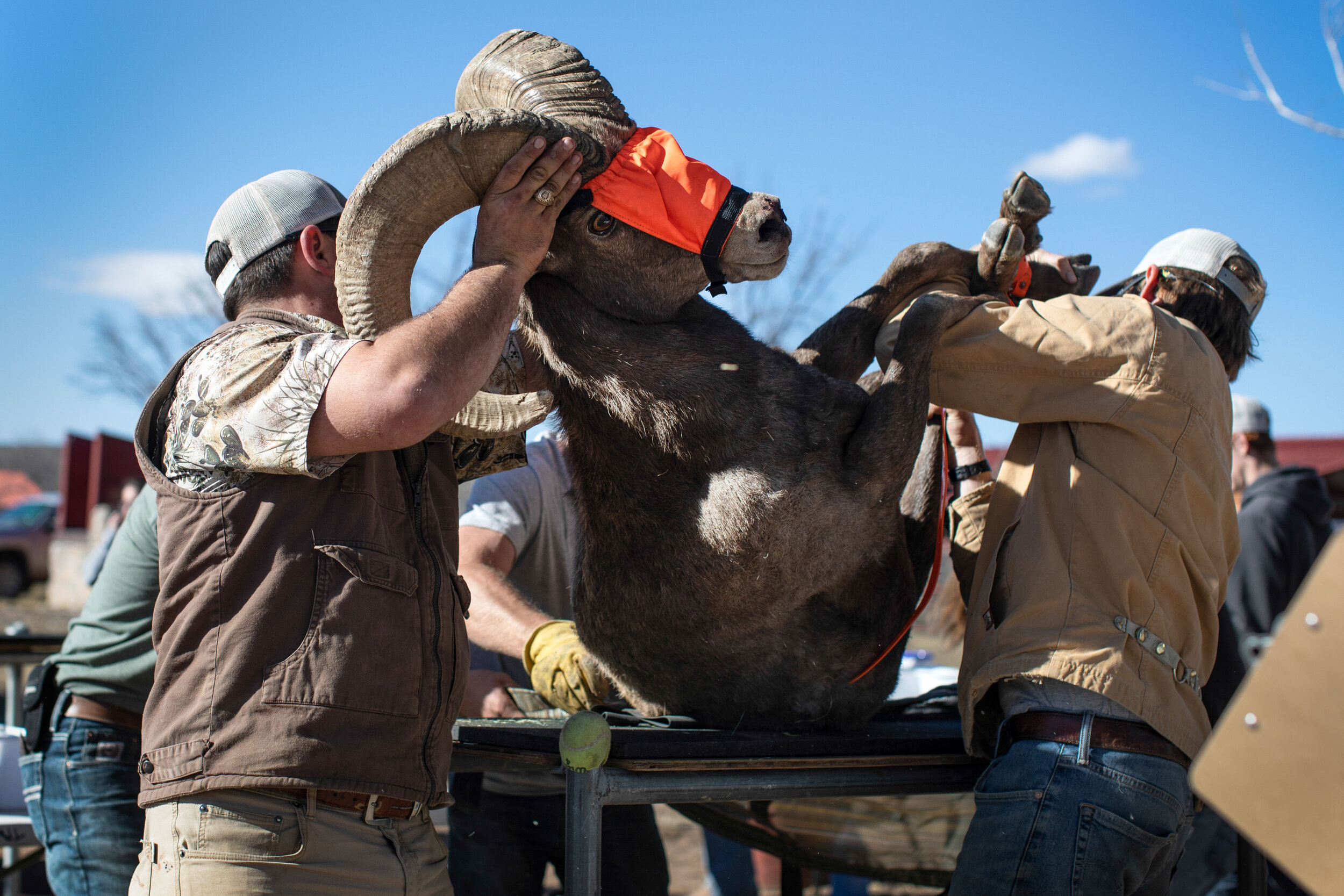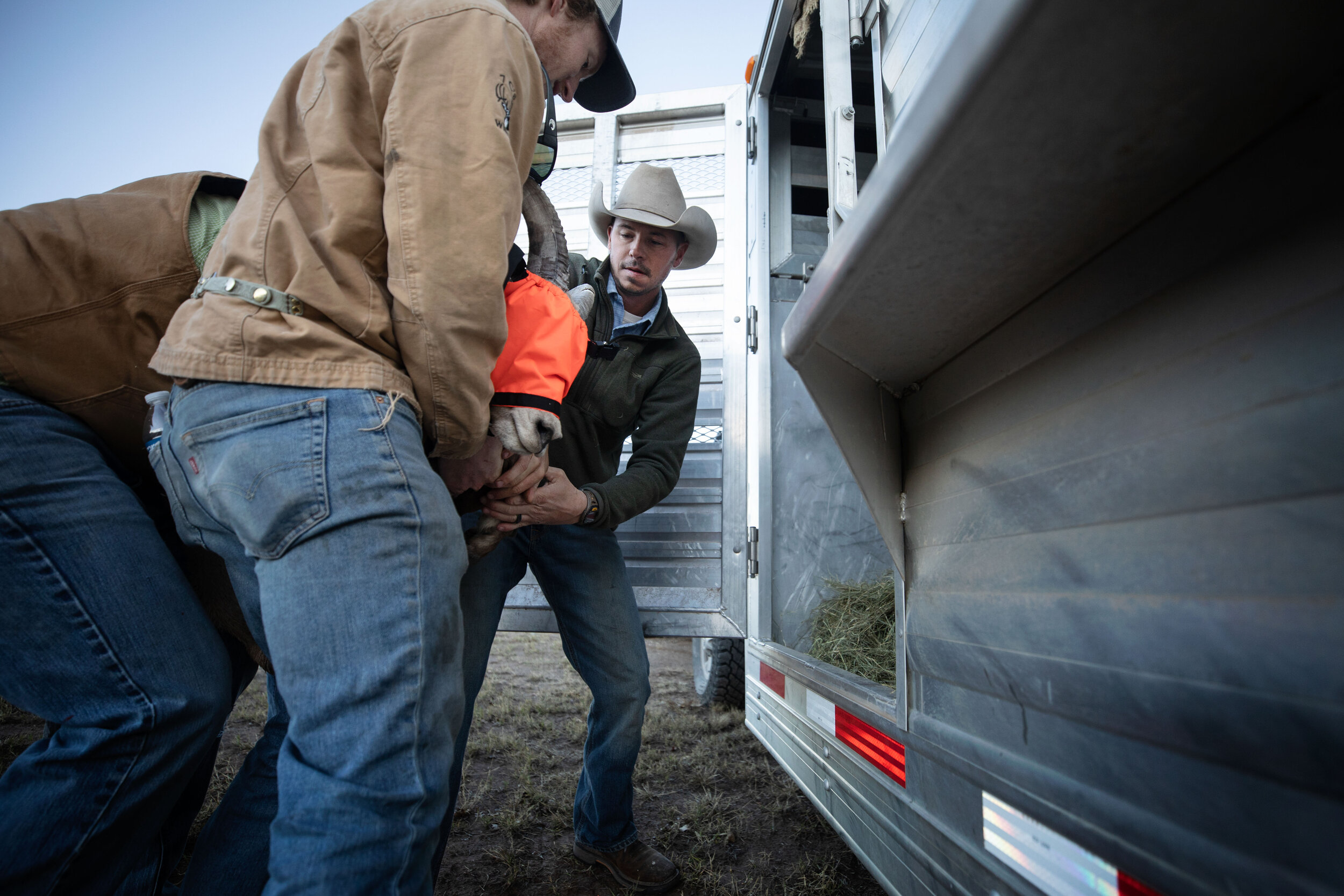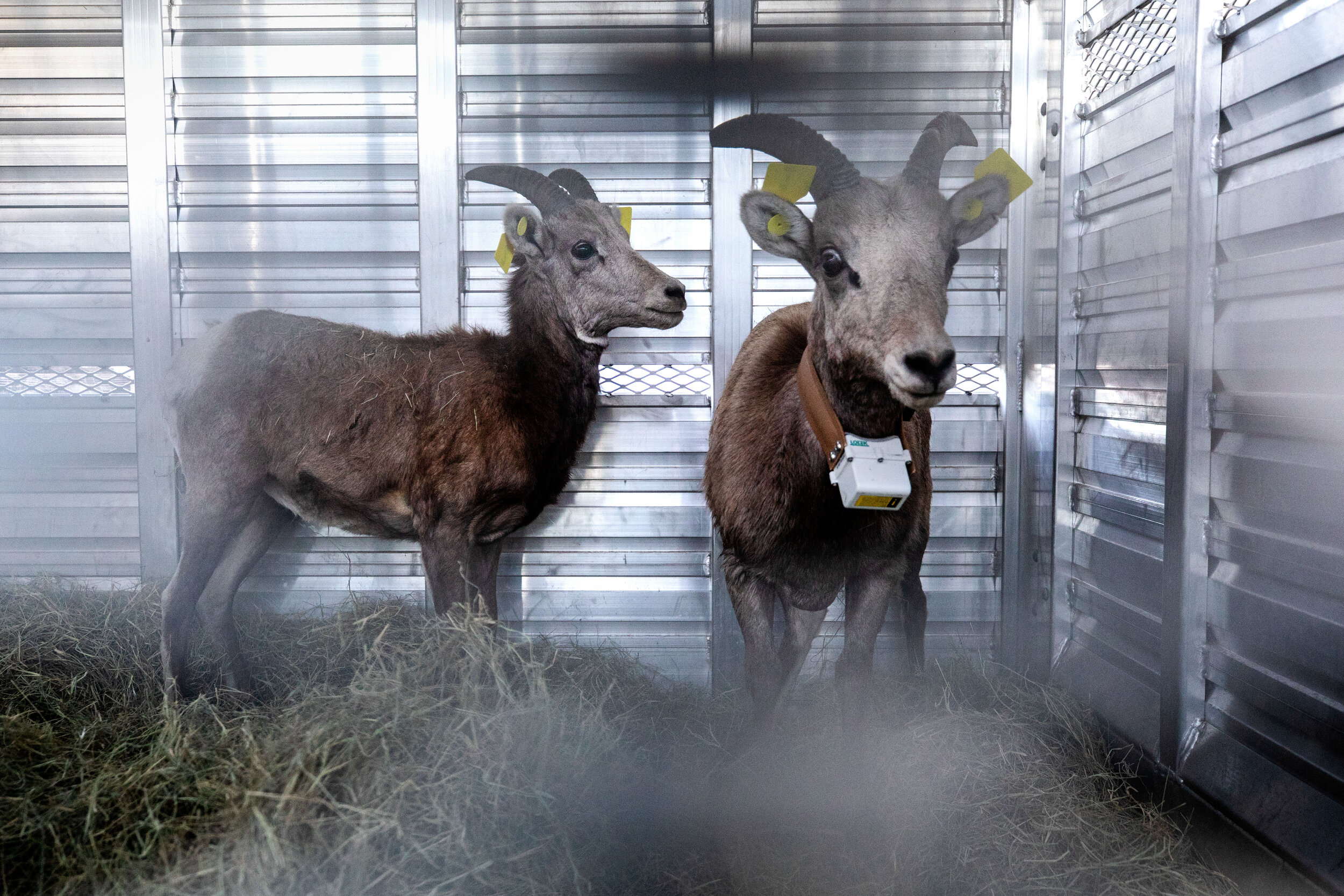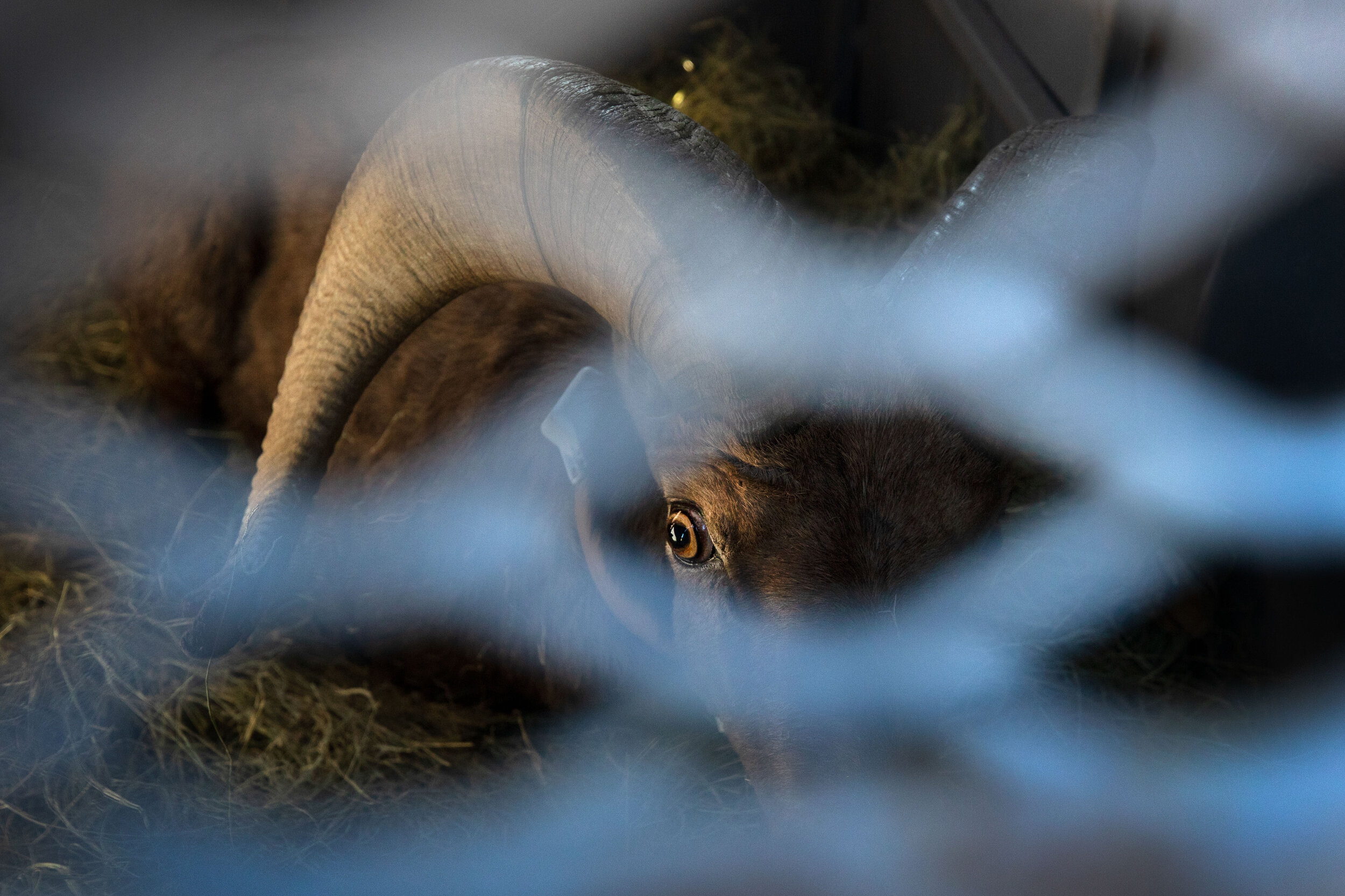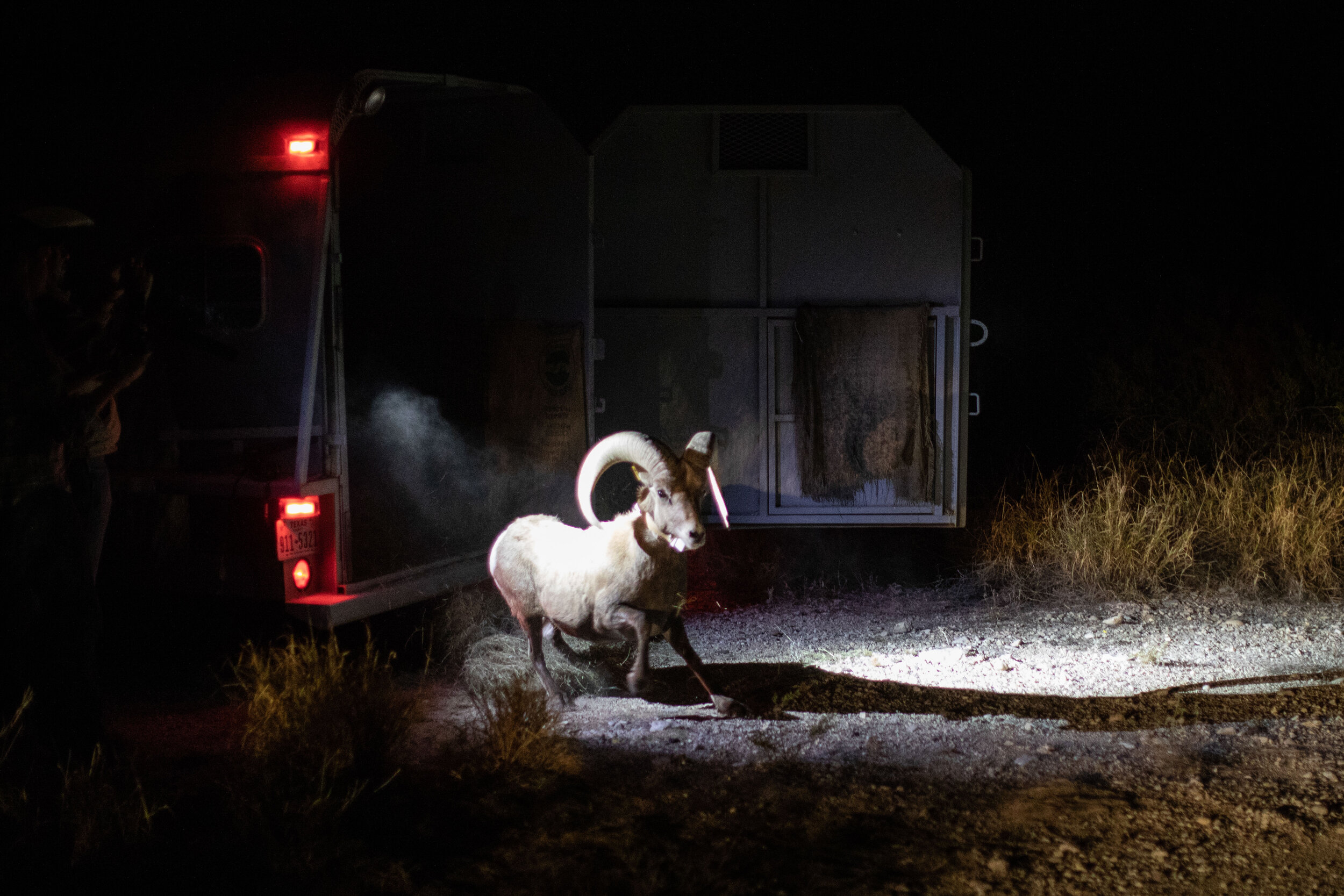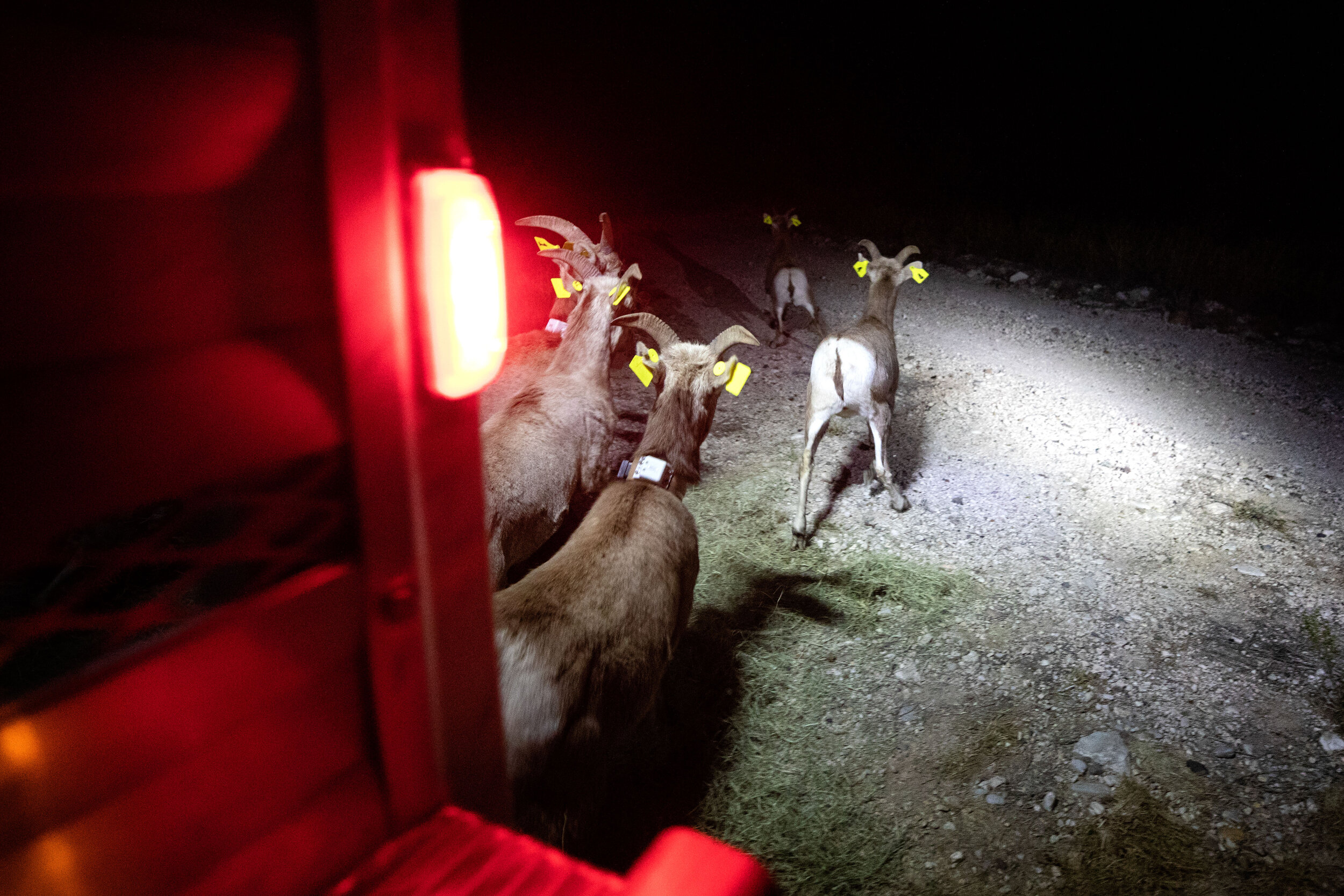Protecting Texas’ Bighorn Sheep Requires A Hands-On Approach
Words by Michael Marks, Photos by Julia Reihs; full story here.
It’s a clear, cool morning in West Texas, and about 50 people are watching a helicopter wind its way around the south side of Elephant Mountain – a brown, flat-topped summit about 30 miles south of Alpine. The sun isn’t all the way up yet, but you can tell that the helicopter is hauling some unusual cargo.
“Looks like we got some sheep coming in,” says Bob Dittmar, the state wildlife veterinarian for the Texas Parks and Wildlife Department. “Looks like we’ve got some slung in there.”
Dangling about 15 feet from the bottom of the helicopter are two desert bighorn sheep. It’s early, but they’ve already had quite a day. Capturing sheep by helicopter requires flying close enough to them to catch them in a net. Then a crew member called a mugger jumps out of the helicopter, blindfolds the sheep, and ties their legs together. Once the animals are immobilized, the mugger wraps them in a full-body sling, which is then attached to the cord dangling below the helicopter.
From there, the sheep are flown to the drop-off point. Today, that’s a barren patch at the base of Elephant Mountain. The helicopter’s blades kick up a thick haze as the pilot, Earl Watters, gingerly lowers the sheep to the ground. They touch down, tip over, and wait. There’s not much else for them to do.
Back from the dead
Desert bighorns are picky when it comes to habitat. But they’ve thrived on Elephant Mountain.
“Elephant’s been a very successful breed site,” Dittmar says. “That probably combines good habitat, good management, and just a little bit of luck.”
They’ve been a little too successful, in fact. The most recent census of the species showed about 185 bighorns on the mountain. But there’s not enough food or space to support that many sheep. Thus, the helicopter – it’s part of a huge and complex operation by Texas Parks and Wildlife to relocate some of Elephant Mountain’s bighorns. The department rarely does this, but it’s critical to the species’ long-term survival in Texas. The plan is to catch 74 of the sheep, gather as much data about them as they can, and then release them at Black Gap Wildlife Management Area, 50 miles to the southeast.
“It’s helping the population here at Elephant Mountain by alleviating the browsing pressure, and helping…augment the population at Black Gap,” says Froylán Hernández, the desert bighorn sheep program leader for Texas Parks and Wildlife.
Hernández’s job is to protect the present and future of Texas’ bighorn herd – no small task. As strong as individual bighorns appear, their population is fragile.
They’re native to West Texas – you can find ancient petroglyphs of them out here. But as recently as the 1960s, there were no bighorns in the state whatsoever. Ranchers moved into the area in the early 20th century to raise domestic sheep and goats, and pushed out the bighorns. The wild sheep died from diseases carried by their domestic cousins, and the ranchers’ fences impeded their movement, isolating herds. They were also hunted with impunity.
“There were [hunting] regulations in place, but really no one out there to enforce them, so [desert bighorns] could be hunted essentially at will,” Hernández says.
Ever since bighorns died out in Texas, the state’s been trying to bring them back. But it’s been a slow process. It’s taken 80 years to restore their population to what it was before the wool industry moved in. And there’s still a long way to go – state wildlife officials’ goal is to repopulate their entire historic range with about 3,000 animals. Right now, they’re halfway there – which is why relocation events like the one at Elephant Mountain are so important. Manually spreading bighorns throughout West Texas gives them a better chance at long-term survival. Individual herds get room to grow, and insulation from transmittable diseases like pneumonia – which has decimated bighorns in other states.
‘Every conceivable sample’
Back at the base of the mountain, about 50 biologists, veterinarians and volunteers watch the helicopter drop off the two sheep. Once it flies away, volunteers hustle over, and carry the bighorns 20 yards to a makeshift biology lab – tables of syringes, vials, clamps and sterilizing liquids – tools to squeeze every available bit of biological data out of these sheep. They’re led by veterinarians like Walt Cook of Texas A&M.
“When we do a capture event like this…we try to take advantage of that and get every conceivable sample we need or might need in the future,” says Cook.
The Texas Parks and Wildlife Department relocate Desert bighorn sheep from Elephant Mountain to Black Gap Wildlife Management Area. Native to West Texas, the Desert Big Horn sheep’s population dramatically decreased with the growth of the domestic sheep herding industry.
There is still a lot that’s unknown about bighorns, and biologists rarely have a chance to get their hands on one. The samples gathered at the relocation event will be tested for various bacteria and diseases, and will help biologists better understand what a healthy herd should look like.
The sheep are still blindfolded and hobbled as they’re set down on an examination table. The scene resembles the focus and frenetic pace of pits at the Indianapolis 500. It’s critical to gather the data as quickly as possible while stressing the sheep out as little as possible. Deaths at these capture events are rare, but they do happen.
The process starts with taking each bighorn’s temperature and a blood sample. They’re surprisingly compliant as veterinarians tilt their heads back to slide a long syringe into their jugular. Occasionally one’s breathing gets heavy but they don’t struggle or fight, though, they could. Up close, their strength is obvious – huge leg muscles designed to propel them up steep cliffs, and ridged curlicue horns that look like ancient weapons.
Simultaneously, other volunteers are collecting hair samples, and attaching a numbered yellow tag to each of the sheep’s ears. Veterinarians like Cook and Dittmar wrench each bighorns’ jaws open to swab its tonsils. The finishing touch is a radio collar attached snugly around the sheep’s neck. Then they’re loaded into a livestock trailer – a hazardous task, since their legs have to be unbound first. Stuffing each one into its own compartment sounds calamitous – horns and hooves clanging against the trailer’s aluminum siding – but no sheep or humans are harmed.
A new home
Over the course of three days, 74 bighorns go through this process. Each day’s captured sheep are trucked two-and-a-half hours away to their new home at Black Gap Wildlife Management area – a 100,000-acre spread along the Rio Grande that’s 50 miles from Elephant Mountain.
It’s pitch-black outside when the convoy arrives at Black Gap for the first release. Headlights illuminate narrow strips of the desert as the four trailers maneuver toward a rocky hill, 30 yards away. Once in place, Travis Smith, a biologist at Black Gap, prepares to open the first door.
“Y’all ready?” he asks the reporters and fellow Parks and Wildlife employees assembled on either side of the trailer. Diesel engines blot out the quiet. Smith unlatches the door, opens it wide…and nothing happens.
The first sheep just stands there.
Smith and Hernández bang against the trailer, trying to get the sheep to move.
“Dale gas!,” shouts Hernández. Eventually, it works. The first sheep hops out of the trailer, bounds down the road, and fades into the brush. One by one or two by two, the rest of the sheep get released in the same way. Sometimes they stand in the light of the trailer a moment, perhaps unsure of where to go, before they’re drawn in by the hill in front of them.
It’s the first time all day we’ve seen them move out in the open. They’re fast, surefooted, speeding up as they hit the rocky slope ahead of them. They look right at home out here.

